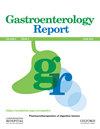膈疝:风险因素以及胃镜检查中的临床和内窥镜问题
IF 3.8
3区 医学
Q2 GASTROENTEROLOGY & HEPATOLOGY
引用次数: 0
摘要
背景 食管裂孔疝(HH)是胃镜检查中的常见病。本研究旨在调查接受食管胃十二指肠镜(EGD)检查的患者中,根据年龄、性别和手术指征出现 HH 的频率。方法 在 2016 年至 2021 年期间,在七个内镜科室开展了一项多中心回顾性研究,其中包括所有的 EGD。研究收集了人口统计学信息、手术适应症和首次胃肠镜检查结果。结果 在检查的 162,608 例胃肠镜检查中,96,369 例(59.3%)为女性患者。在所有胃肠造影检查中,有 39619 例(24.4%)发现了 HH,其中小 HH 31562 例(79.6%),大 HH 3547 例(9.0%)。在年龄小于 50 岁的人群中,HH 的发生率为 16.5%,而在年龄大于 81 岁的人群中,HH 的发生率为 37.3%。在有胃灼热/反流症状的患者中,38.7%(11,370 人)被诊断为 HH;在有吞咽困难的患者中,31.5% 被诊断为 HH;在大便潜血试验呈阳性的患者中,28.5% 被诊断为 HH;在将接受减肥手术的患者中,24.3% 被诊断为 HH。年龄(几率比 1.030)、女性(几率比 1.309)、反流症状(几率比 2.314)和吞咽困难(几率比 1.470)被确定为 HH 的预测因素。结论 有症状患者经胃肠造影确诊为 HH 的风险因素包括高龄、女性、胃灼热或吞咽困难。本文章由计算机程序翻译,如有差异,请以英文原文为准。
Hiatal hernia: risk factors, and clinical and endoscopic aspects in gastroscopy
Background Hiatal hernia (HH) is a common finding in gastroscopy. The aim of the present study was to investigate the frequency rate of HH among patients who underwent esophagogastroduodenoscopy (EGD) according to their age, gender, and procedural indication. Methods A multicenter, retrospective study including all EGDs was conducted across seven endoscopy departments between 2016 and 2021. Demographic information, procedural indications, and findings from the initial EGD were collected. Results Of the 162,608 EGDs examined, 96,369 (59.3%) involved female patients. HH was identified in 39,619 (24.4%) of all EGDs performed, comprising small HH in 31,562 (79.6%) and large HH in 3,547 (9.0%). The frequency of HH was 16.5% in the age group of ≤50 years and 37.3% in those aged ≥81 years. HH was diagnosed in 38.7% (11,370) of patients with heartburn/reflux symptoms, 31.5% of those with dysphagia, 28.5% of those with positive fecal occult blood tests, and 24.3% of those who would undergo bariatric surgery. Age (odds ratio 1.030), female gender (odds ratio 1.309), reflux symptoms (odds ratio 2.314), and dysphagia (odds ratio 1.470) were identified as predictors for HH. Conclusions Risk factors for HH diagnosed by EGD in symptomatic patients were shown to be advanced age, female gender, and the presence of heartburn or dysphagia.
求助全文
通过发布文献求助,成功后即可免费获取论文全文。
去求助
来源期刊

Gastroenterology Report
Medicine-Gastroenterology
CiteScore
4.60
自引率
2.80%
发文量
63
审稿时长
8 weeks
期刊介绍:
Gastroenterology Report is an international fully open access (OA) online only journal, covering all areas related to gastrointestinal sciences, including studies of the alimentary tract, liver, biliary, pancreas, enteral nutrition and related fields. The journal aims to publish high quality research articles on both basic and clinical gastroenterology, authoritative reviews that bring together new advances in the field, as well as commentaries and highlight pieces that provide expert analysis of topical issues.
 求助内容:
求助内容: 应助结果提醒方式:
应助结果提醒方式:


